Another D-Lev Digital Theremin Build Project
D-Lev Model P3, Serial Number 0002
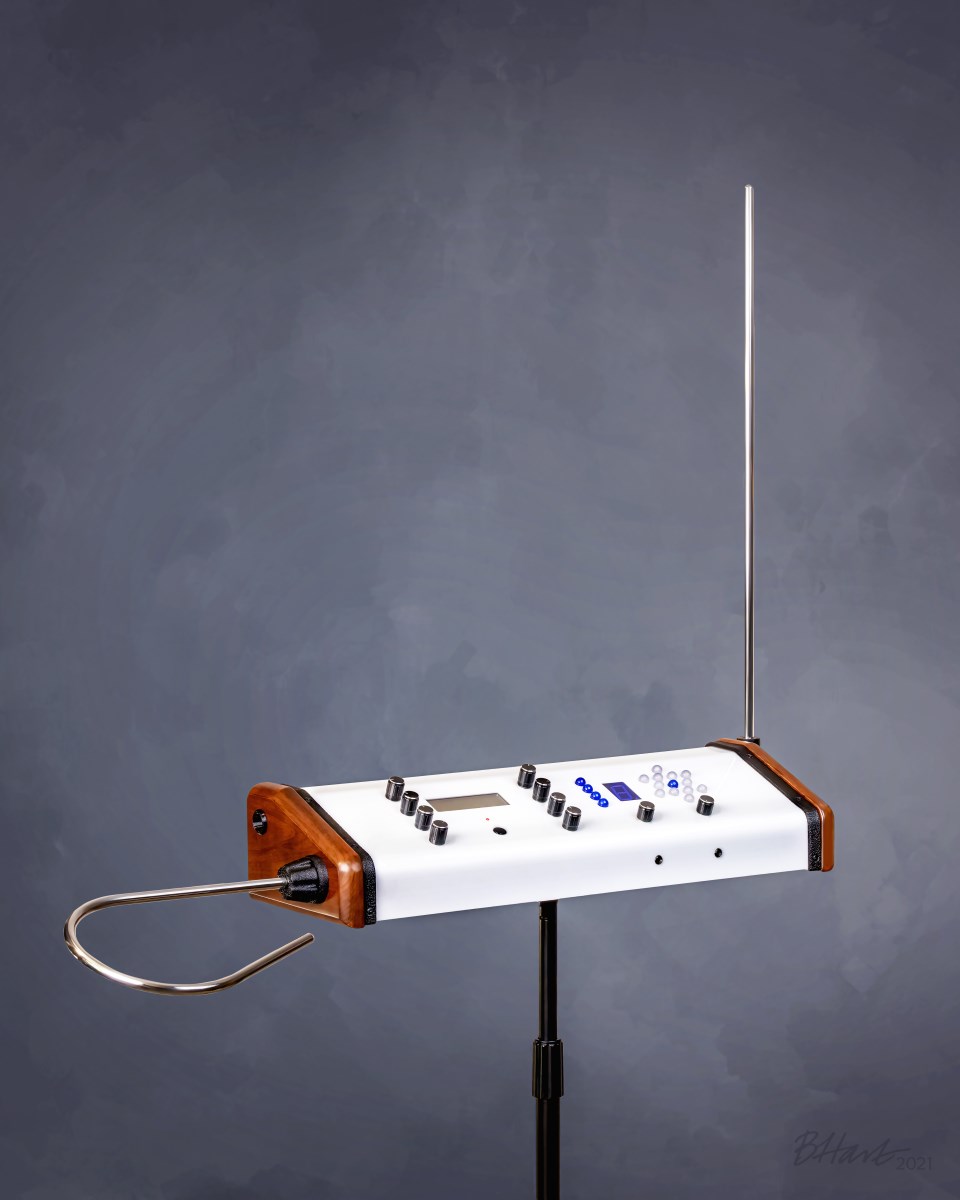
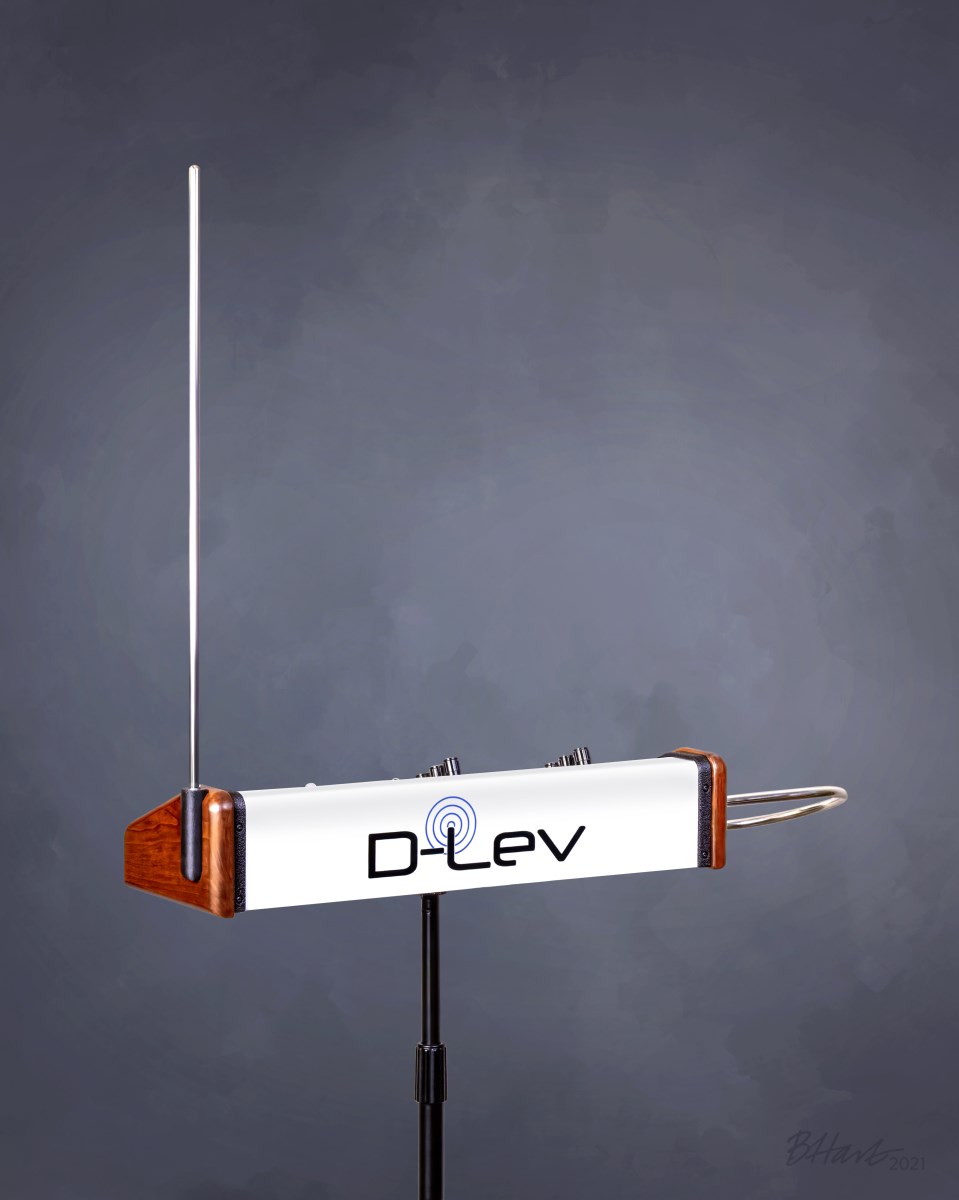


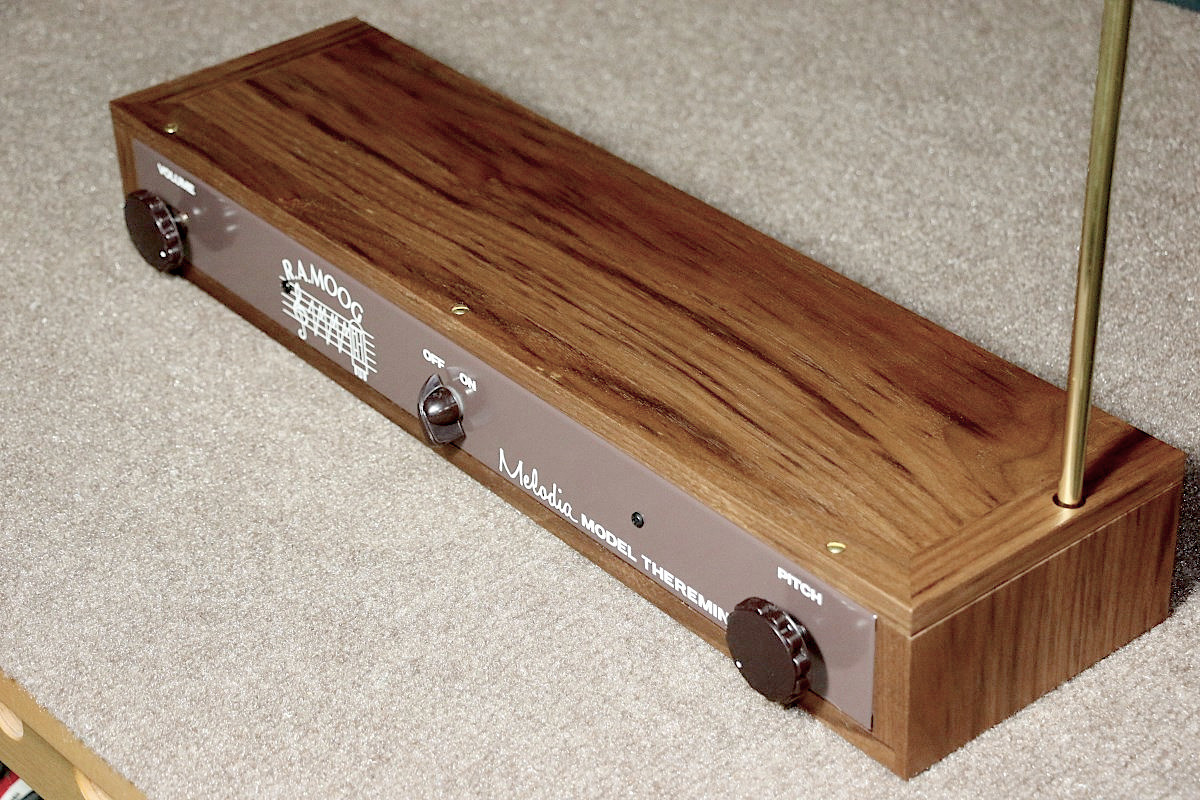
This model lacks the traditional volume loop antenna on the left side, instead using a plate of metal on the end of the cabinet (not visible here).
I don’t know why I became fascinated with the Moog Melodia enough to want to build a reproduction. The physical appearance is very basic, and it has no timbre control, so you’re stuck with a single voice. Part of the motivation for the project is that I enjoy doing restorations and have a great appreciation for the craftsmanship of antique and vintage items. I also enjoy building from scratch, especially if the project has a nice mix of woodwork, metalwork, and electronics. With the Moog Melodia I get all of these. I had no expectation going in that this was going to be a great theremin, but in the end it turned out to be better than expected, and it was fun to try to build something different.
I think the fact that the Melodia is well-documented helped to keep the scope of the project down to something that I was willing to do alongside other projects that are also competing for time.… Read the rest
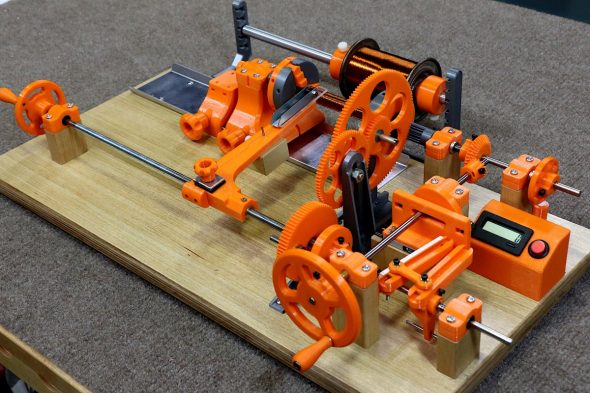
The mostly-completed progressive/universal coil winder. The universal portion is my adaptation of Morris Coilmaster design with some added features. The progressive feature is new. All parts were designed in Fusion360 with the exception of the very nice 3-jaw chucks posted by user “mdkendall” on Thingiverse.com (link in text below).
A few years ago I became fascinated (obsessed) with theremins to the point that I’ve ignored maintenance of this website and I’m pretty sure I can’t even play guitar anymore. The theremin is a miserably difficult instrument to play, but in the early morning hours when no one else can hear me I find a deep satisfaction in playing a musical instrument that almost seems to be connected directly to my brain. If you can think of a melody you can play it (how well you can play it is another matter).
It’s strange that I resisted the theremin for so long in my younger years. It is a natural fit in that it is an electronic instrument that uses radio frequencies and oscillators and filters, all stuff that I’ve been into since my pre-teen years. The theremin story is for another time, though. This project, a coil winder that allows one to make high-frequency coils with winding patterns that are impossible to do by hand, is actually a side task for a theremin construction project that I’ve managed to stretch out for over a year now. … Read the rest
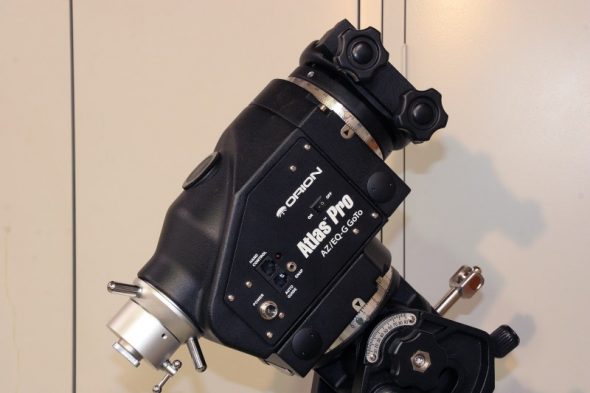
The Atlas AZ-EQG mount is a popular and affordable dual-mode ALT/AZ and equatorial go-to mount manufactured in China for the Taiwanese company Synta and distributed in the US by Orion Telescopes and Binoculars. A nearly identical model (in white instead of black) is distributed (outside the US, for now) under the SkyWatcher name and goes by the AZ-EQ6 model number. Another Synta model that is even more popular in the US is the Atlas EQG, an equatorial-only model that is also sold in the US and worldwide as the Skywatcher EQ6.
The wider popularity of the basic EQG and EQ6 models has resulted in a good amount of user information being shared in the astronomy community, including some well documented disassembly and tuning procedures. The information on the AZ models is a little less plentiful, so I thought it would be helpful to document some of the steps that I went through while cleaning, lubricating, and tuning my mount recently.
While the basic and the AZ- mounts have many similarities in size and weight capacity, they are quite different in their construction and the disassembly procedures for one model aren’t particularly helpful for the other. In searching through the forums I was able to find some disassembly pictures and information that was helpful to get me started, and I hopefully I can add some additional photos and insight of my own.… Read the rest
It’s been almost a year since I’ve had time to post anything, but I’ll break internet silence with something quick and easy. A combination of a lunar eclipse in near-perfect weather and a break between home projects motivated me to dust off the telescope and haul it out to the backyard to use as a tracking platform for my DSLR camera and one of my wife’s telephoto lenses. I almost passed on the opportunity since there would always be better internet images available on the morning after (or even in real time), but what the heck…
It has been so many years since I have had the telescope set up in our backyard that the trees have grown to the point that the view of the celestial pole near Polaris – from the telescope’s position – is totally obscured. The eclipse was to start early in the evening and there wasn’t a lot of time to futz with tracking a star and making adjustments, so I used the SkEye app on my phone (placed flat against the wedge base) to set the telescope mount roughly to the correct position during the day. … Read the rest
The Optoma HD20 is a fairly popular DLP projector with a 1920 x 1080 native resolution and an attractive price tag. It also seems to be afflicted with an unusual tendency to suddenly develop a diffused dark area (sometimes inaccurately described as a blurry area) that may obscure part or nearly all of the projected image. This sudden darkening may also be accompanied by a strong smell of melting plastic, because as in the case described here, plastic is actually melting and charring.
I had been looking for a full HD projector to use to build a high-resolution 3D printer, and I ran across this unit suffering from the dark spot problem on Craigslist for $100. I was aware that projectors with this problem could be user-repairable, and when I looked at the unit I was able to see enough to determine that the large dark area on the right side was indeed caused by a melted inner lens.
The cause of the dark region on the projected image is an oddly-shaped aspherical plastic lens that is the final element in an optical path that channels light from the reflector lamp on the left front of the unit. … Read the rest
It’s been a busy home-project summer (as in home-maintenance) but there have been a few shop projects that I have not had time to write about. One of these projects was the fabrication of a video camera that could be swapped for the milling cutter and used to precisely place a target under the cutter visually rather than by the numbers.
Sometime last spring I got the urge to buy and perform a CNC conversion on a small Grizzly G0704 milling machine. Before beginning this project I knew there would be a need to machine stepper-motor adapters and other hardware components to a higher degree of precision and accuracy than I routinely care about. And since many of the parts would have to mate with the machine castings, I needed a way to measure dimensions and hole spacings more accurately than by simply using a dial caliper.
Many other DIYers have built spindle cameras (I’m calling this one a mill-cam from here on), and a web search turned up several different approaches. I incorporated many of their ideas into this design and added a few of my own, including the ability to adjust the tilt the vertical axis of the camera.… Read the rest
Quote from the YouTube information:
“A rare 1920s automaton built by the Character Display Company in Chicago Illinois. Stored away and forgotten for about 60 years, this Mechanical Salesman is in amazing condition, still works like new and has his original shipping/storage case. Written & Narrated by Kurt Reichenbach.”This well-produced video showcases a highly animated display that has some similarities to the Issasse coffee-drinking automatons shown in the previous post. The eyes and eyebrows are very active, and the mouth moves with a flexible and seamless joint. And like Issasse, the mechanism appears to have seven independent motions for the various features, head, and arms. It is animated by six cams (with one of the end cams side-pinned to serve double duty), all driven by a worm gear speed reducer. The motions include left arm, right arm, head tilt, head pan, eyebrows, eyes, and mouth.
The manufacturer was the Character Display Co., 3249 Lakewood Avenue, Chicago 13, Illinois.
Here is what appears to be a similar display outfitted a little differently and ringing a bell instead of waving a stick:
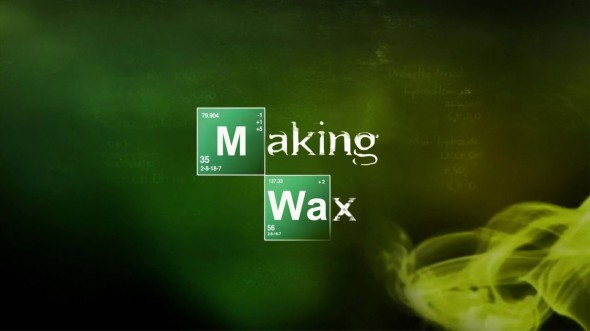
Sculpting and hand carving are skills that do not come naturally to me. I can visualize, create, and generally comprehend geometric forms, but there are some things that I just cannot see while working on shapes in nature, and this includes human faces and figures.
I do still need to be able to create an acceptable figure or head now and then for automaton or animatronic projects, but unless some skill develops it is destined to be a “rework until good enough” endeavor. I can live with that shortcoming as long as the job can still eventually get done. It does however require the selection and use of sculpting or carving materials that can tolerate a lot of mistakes and rework. The ideal material would be easily hand-moldable yet firm enough to hold shape and detail without fear of damage from the slightest mishandling. It must carve easily, but it should also allow easy addition of material to fill in mistakes.
After trying a few different types of sculpting media (water-based and polymer clays, oil based plasticine, basswood, carvable foam) I decided that carving wax was a material that I could live with.… Read the rest
One of the perks that you lose when abandoning the corporate engineering environment is the access to high-end test equipment to use or borrow for your own projects, and one of the things that I missed the most was having a good quality stereo microscope within reach. Working with microwave ICs and picosecond-range pulse circuits required spending a good portion of the work day staring through microscopes while assembling die-level circuitry and performing wirebonding. Microscopes were so common in the workplace that I never really understood how pricey they were until I had to purchase a Leica scope & wirebonder and the ocular-less Mantis for general assembly work in my development lab.
I have always had some of my own basic gear at home – oscilloscopes, a logic analyzer, and other basic equipment – but no network or spectrum analyzers, and no microscope. Surplus name-brand scopes in decent condition can still command high prices, and I was recently looking for a nice used Nikon or Leica when this AmScope stereo boom microscope happened to arrive courtesy of Santa Claus. A few years earlier I had come very close to purchasing a different AmScope model based on a high percentage of favorable reviews.… Read the rest
A Little History
The Instructograph is an early electromechanical playback device used for learning Continental or American Morse code. Several different models were manufactured by the Chicago-based Instructograph Co. from the 1920s all the way into the 1980s. Learning to receive code is generally a more difficult task than learning to send, and this portable device would allow the student to practice code recognition without the aid of an instructor or fellow student.
Reels of oil-impregnated paper tape perforated with dots and dashes were used to actuate a set of electrical contacts that would in turn operate an external railroad-type sounder, a buzzer or oscillator (for tone), or a light for optical communication. The earliest versions of the Instructograph used a wind-up phonograph motor with a variable speed governor to power the rotation of the tape reels.
Other than the mechanical motor, the only other elements in the device consisted of a set of contacts, a battery, and a rheostat to control the current to the sounder or buzzer.
Later versions used a variable speed electric motor for the tape drive, and some actually included an on-board electronic oscillator that would produce an adjustable audio tone.… Read the rest
This is not a new video, but this piece by François Junod is probably the most stunningly beautiful and complex automaton mechanism I have ever seen, contemporary or antique. In the context of what can be seen in this video it appears that there were no shortcuts, no compromises, and no cost-reductions – this is mechanical design done right.
But functionality was clearly not the only goal. The level of workmanship and finish detail on every piece part is unsurpassed and elevate this to a true work of art. I have been impressed by both the automaton and the video presentation since I first viewed it a couple of years ago, and I see a little more every time I watch it.
I thought it might be of interest to make some notes about how the mechanism appears to operate. I am no expert on anything, and I will make a disclaimer here by saying everything written below is my opinion or best guess and may not be accurate.
Points of Interest – Timeline
NOTE: Some sections of the video are only a fraction of a second in length. It may be helpful to open the video in a second browser if you are trying to follow along with the text.… Read the rest
Sometime in the late 1970s I became fascinated with researching and collecting antique game machines, candy vending machines, and other amusement devices. My interests were at first focused on those machines that I vaguely remembered from rare visits to a penny arcade as a youth in the ’60s, and even then I was drawn to the artistic design and mechanics of the earlier designs with their art deco lines or ornate castings and wood cabinets. It wasn’t until I started locating information and pictures of these early amusement devices that I became more consciously aware that I had personally encountered many of them at fairs, in drug and dime stores, and in the local movie theater lobby.
Even in the ’60s, the penny arcade that traveled with the amusement show for the annual county fair was loaded with machines that dated back into the early ’30s, and possibly even earlier. By the time I developed the bug to start seeking out and collecting items from this era the market for coin-operated collectibles was hot and getting hotter, due in part to west-coast publications and shows that were fueling speculation and driving prices upward.… Read the rest

Reset or Deauthorize Any Streaming Accounts Before Selling or Returning Network TVs or Streaming Media Players
Okay, maybe the rest of the world knows about this, but I didn’t until a few days ago. And at least a couple initial levels of Amazon tech support didn’t recognize the source of the problem either…
To be more specific, the unauthorized streaming discussed here refers to a situation where your legitimate streaming account is being accessed and used by a party not known to you, the streaming account holder. This party can view your watchlist and your list of recently viewed movies, and you can view theirs. It’s an unwillingly shared account where you are the only one paying the subscription fee. The freeloading party almost certainly knows that they are tapped into someone else’s account; however it is possible that you may be unaware that anything is wrong if you don’t access your viewing history.
We subscribe to both Amazon Prime and Netflix streaming accounts, both of which have a recently watched category that displays any past movie or TV program that was played long enough to register. Netflix gets used the most in our house and has this list on its main movie page (at least on my Roku XS – other devices may differ), so it is visible every time you browse the movie lists.… Read the rest
One downside to the ultra-miniaturization camcorders and other video recording devices is the increased difficulty in holding the camera steady. The earliest camcorders, despite their awful video quality by today’s standards, did from a pure stability standpoint have the inherent advantage of larger size and mass going for them. Resting a heavy camera on the shoulder tames some of the worst jitters, but palm-sized cameras simply aren’t large enough in any axis to stabilize against the body.
Using even the simplest video stabilizer with a camcorder can result in a large improvement in picture stability. Optical and digital stabilization in camcorders can only fix a limited amount of camera mishandling – it pays to have a stable platform to start with. Learning to balance and operate a stabilizer effectively will take a fair amount of practice, but even if your movements do initially wallow around a bit when tilting and panning, the worst jitters will be gone almost from the moment you start using it.
I probably shouldn’t start off trying to explain physics behind video stabilizers – it’s a topic that is well-covered elsewhere, and you may want to skip this beginning part if you are more interested in the project.… Read the rest
Resistance Soldering
Resistance soldering is a process by which objects to be soldered together are heated by passing a current through them rather than by applying heat from an external source. Localized heating is caused by relatively high current passing through the resistance of the junction. As long as the heating rate of the junction exceeds the thermal dissipation rate, the temperature will rise high enough for solder to melt and flow.
There can be several advantages to using resistance soldering for certain applications, but two big ones stand out:
This was a fairly extensive restoration project that was completed in the mid 1980s. I had begun to write an article about it for one of the coin-op collector magazines of the time, but the magazine closed its doors before it was finished. I’ve probably forgotten a lot of details of the restoration, but that will help keep the story to a reasonable length. It was an interesting project because it went beyond the scope of a normal slot machine restoration and required the re-creation of many missing and broken parts. In the end it turned out to be a beautiful piece that is still part of my collection.
This restoration project predates digital photography, so the few pre-restoration pictures that I have were taken with a film camera and the prints scanned. The quality of the film images is poor, and I wish I had been more thoughtful about documenting things in the past. Thankfully I was able to retake all of the post-restoration photos (20 plus years later) with better lighting and a better camera.
I should note that the two framed cards above the handle appear to be some generic reprints and are probably not correct for this machine.… Read the rest
I would guess that LCD TV enthusiasts, owners, and potential buyers that lean more toward the videophile/home-theater end of the spectrum represent a fairly small percentage of the overall market. If you are part of this minority and follow discussions on AV forums dedicated to such topics, you will learn about quality control issues that plague just about every make and model of flat-panel TV on the market. In some cases you will learn about flaws that you may never have noticed on your own, and once they are seen they usually can’t be unseen. But it is better to be able to spot a problem immediately within a return or warranty period than to suddenly discover it on your own when it is too late. Being informed can assist you in making a better choice in selecting a TV; it can also cause frustration to find out that no matter what make or model you choose, luck almost always plays a role.
It is pure speculation on my part, but it seems plausible that the Edge-Backlit LCD TV business model has settled on this general quality control philosophy:
If it lights up and displays a picture, ship it.… Read the rest
I don’t know how long these have been available, but they are pretty cool. These testers are all over eBay in various forms for around this price, give or take. After ordering this I found a different one for about $23 with a built-in ZIF socket, which would have been handy instead of the pin socket shown here. But that didn’t have the ultracool white-on-blue backlit display.
I am really surprised how well it works. It runs on a 9v battery. There are three available connection points (pins 1-2 are connected, as are pins 4-5 on the socket) marked T1, T2 and T3. For 2-terminal devices use any two connections, and for transistors use all three. You do not need to know diode or transistor lead configurations for the test – it finds them for you. SMD pads are available on the main board itself for testing surface mount components.
When a device is connected and the test button pressed, the display initially shows the battery voltage. After a short time the display will show a symbol of the component and the assignment of the pin numbers in accordance with the way you have the part connected.… Read the rest
Right or wrong, and subject to controversy, these are the general steps that can help produce bubble-free parts or molds using resin or silicone rubber:
This was a fun little side project that came out of nowhere.
I was approached to help with development of a working prop for a stage play that was in the works for a Minneapolis theater. The prop needed to be a candy machine, specifically a Lifesaver vending machine that would be rigged to hit the jackpot and spill at least twenty lifesaver rolls out on the floor when a lever was pressed. It also had to take a coin, but that did not need to be part of the functional mechanism. There was no requirement that the prop look authentic; it just had to be recognizable as a candy machine.
The play was based on a story set in a department store the 1960s, so there was a real opportunity to make something more decorative than a simple box vending machine of later decades. I had been handed a few functional requirements and tentative dimensions, but I was already fixated on the idea of making something in the deco style of a vintage Stoner candy machine, some versions of which vended both candy bars and roll candy.… Read the rest
This whole tangent – acquisition of a small lathe – started when I had a need to make a tiny 1/8″ diameter internally-threaded sleeve for tensioning a thin aircraft cable. The aircraft cable would have a small brass collar crimped and silver soldered on the end, and the sleeve would rotate freely on the cable as it threaded onto a 4-40 rod, thereby tensioning the cable. The problem wasn’t that I couldn’t chuck the small parts on my Logan/Wards 10″ lathe, but that the lathe couldn’t really achieve the spindle speeds needed to do a good job on the small-diameter parts.
For several months I had been looking for a smaller lathe – something of the Sherline variety – that would be more comfortable to work with at higher spindle speeds. I knew a little about the Taig lathe, but for some fickle reason I didn’t seriously consider it until later in the process. Early on I had also started watching for vintage Unimat lathes on eBay. A Unimat would not be the most practical choice, but I had been fascinated by them since the ’60s when their ads could be seen everywhere in hobbyist magazines and catalogs.… Read the rest